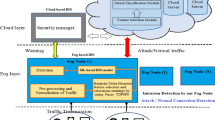Abstract
Cyber-physical systems (CPS) are multi-layer complex systems that form the basis for the world’s critical infrastructure and, thus, have a significant impact on human lives. In recent years, the increasing demand for connectivity in CPS has brought attention to the issue of cyber security. Aside from traditional information systems threats, CPS faces new challenges due to the heterogeneity of devices and protocols. In this paper, we assess how feature selection may improve different machine learning training approaches for intrusion detection and identify the best features for each intrusion detection system (IDS) setup. In particular, we propose using F1-Score as a criteria for the adapted greedy randomized adaptive search procedure (GRASP) metaheuristic to improve the intrusion detection performance through binary, multi-class, and expert classifiers. Our numerical results reveal that there are different feature subsets that are more suitable for each combination of IDS approach, classifier algorithm, and attack class. The GRASP metaheuristic found features that detect accurately four DoS (denial of service) attack classes and several variations of injection attacks in cyber physical systems.









Similar content being viewed by others
References
Alcaraz C, Lopez J (2014) Diagnosis mechanism for accurate monitoring in critical infrastructure protection. Comput Stand Interfaces 36(3):501–512
Alcaraz C, Lopez J (2014) WASAM: a dynamic wide-area situational awareness model for critical domains in smart grids. Future Gener Comput Syst 30:146–154
Almomani I, Al-Kasasbeh B, Al-Akhras M (2016) WSN-DS: a dataset for intrusion detection systems in wireless sensor networks. Journal of Sensors 2016
Ashibani Y, Mahmoud QH (2017) Cyber physical systems security: analysis, challenges and solutions. Comput Secur 68:81–97
Bermejo P, Gámez JA, Puerta JM (2011) A GRASP algorithm for fast hybrid (filter-wrapper) feature subset selection in high-dimensional datasets. Pattern Recogn Lett 32(5):701–711
Dahi ZA, Alba E (2020) The grid-to-neighbourhood relationship in cellular GAs: from design to solving complex problems. Soft Comput 24(5):3569–3589
Díez-Pastor JF, García-Osorio C, Rodríguez JJ (2014) Tree ensemble construction using a grasp-based heuristic and annealed randomness. Inf Fusion 20:189–202
Diez-Pastor JF, García-Osorio C, Rodríguez JJ, Bustillo A (2011) GRASP forest: a new ensemble method for trees. In: International workshop on multiple classifier systems, pp 66–75. Springer
Esseghir MA (2010) Effective wrapper-filter hybridization through GRASP schemata. In: Feature selection in data mining, pp 45–54
Goh J, Adepu S, Junejo KN, Mathur A (2016) A dataset to support research in the design of secure water treatment systems. In: International conference on critical information infrastructures security, pp 88–99. Springer
Harris E (2002) Information gain versus gain ratio: a study of split method biases. In: ISAIM
Jia D, Lu K, Wang J, Zhang X, Shen X (2016) A survey on platoon-based vehicular cyber-physical systems. IEEE Commun Surv Tutor 18(1):263–284
Kanakarajan NK, Muniasamy K (2016) Improving the accuracy of intrusion detection using gar-forest with feature selection. In: Proceedings of the 4th international conference on frontiers in intelligent computing: theory and applications (FICTA), pp 539–547. Springer
Kholidy HA (2021) Autonomous mitigation of cyber risks in the Cyber-Physical Systems. Futur Gener Comput Syst 115:171–187
Leitao P, Colombo AW, Karnouskos S (2016) Industrial automation based on cyber-physical systems technologies: prototype implementations and challenges. Comput Ind 81:11–25
Moshki M, Kabiri P, Mohebalhojeh A (2015) Scalable feature selection in high-dimensional data based on GRASP. Appl Artif Intell 29(3):283–296
Nourian A, Madnick S (2015) A systems theoretic approach to the security threats in cyber physical systems applied to stuxnet. Trans Dependable Secure Comput 15(1):2–13
Quincozes SE, Kazienko JF (2020) Machine learning methods assessment for denial of service detection in wireless sensor networks. In: 2020 IEEE 6th world forum on internet of things (WF-IoT), pp 1–6. IEEE
Quincozes SE, Passos D, Albuquerque C, Ochi LS, Mossé D (2020) GRASP-based feature selection for intrusion detection in CPS perception layer. In: 2020 4th Conference on cloud and internet of things (CIoT), pp 41–48. IEEE
Ribeiro CC, Resende MG (1999) Algorithm 797: Fortran subroutines for approximate solution of graph planarization problems using GRASP. ACM Trans Math Softw (TOMS) 25(3):341–352
Week S (2020) IoT devices infected via supply chain attack. https://www.securityweek.com/
Yu X, Xue Y (2016) Smart grids: a cyber-physical systems perspective. Proc IEEE 104(5):1058–1070
Yusta SC (2009) Different metaheuristic strategies to solve the feature selection problem. Pattern Recognition Letters 30(5)
Zhang Y, Qiu M, Tsai C-W, Hassan MM, Alamri A (2017) Health-CPS: healthcare cyber-physical system assisted by cloud and big data. IEEE Syst J 11(1):88–95
Acknowledgements
This work is supported in part by CAPES, CNPq, FAPERJ, and CGI/FAPESP.
Author information
Authors and Affiliations
Corresponding author
Ethics declarations
Conflict of interest
The authors declare no competing interests.
Rights and permissions
About this article
Cite this article
Quincozes, S.E., Passos, D., Albuquerque, C. et al. An extended assessment of metaheuristics-based feature selection for intrusion detection in CPS perception layer. Ann. Telecommun. 77, 457–471 (2022). https://doi.org/10.1007/s12243-022-00912-z
Received:
Accepted:
Published:
Issue Date:
DOI: https://doi.org/10.1007/s12243-022-00912-z




